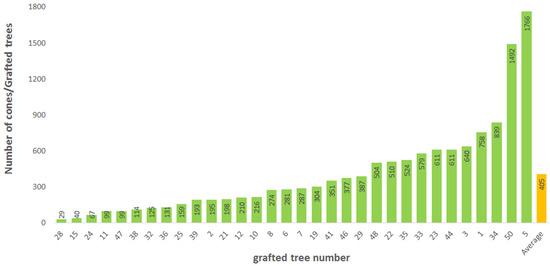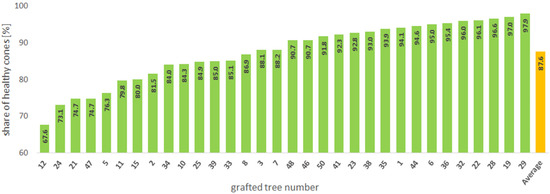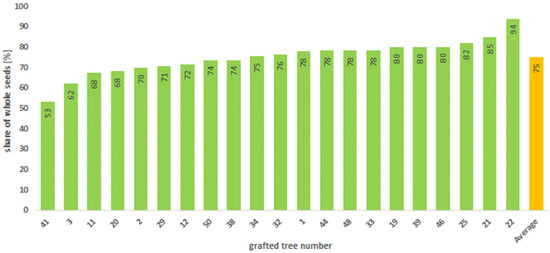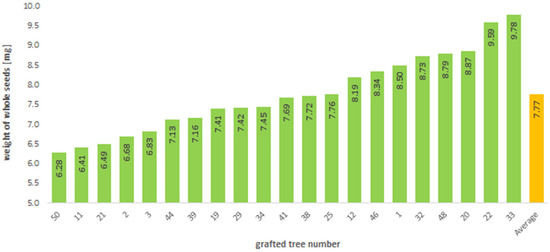Abstract
Climate changes, taking place in Poland, have a very negative impact on populations of many tree species. An example of a highly endangered and, at the same time, very valuable stock is the population of Norway spruce from the Białowieża Primeval Forest. One of the protection methods of a perishing population is to preserve its genetic pool in the form of seed orchards (ex situ method). The genetic material of spruce mother trees from the Białowieża Primeval Forest has been preserved in a seed orchard with an area of 9.74 ha, established in 1996 in the Bielsk Forest District (approximately 35 km west of the Białowieża Primeval Forest). In December 2017, cones from all growing grafted trees were collected on a sample plot of 50 clones. An extensive analysis of the health of cones, seed yield from cones, and the parameters of cones and seeds was carried out, and the relationship between seed quality and position in the cone was determined. The number of cones on the analyzed trees ranged from 29 to 1766, with the average equal to 405 cones per clone. The greatest threat limiting seed production were insects that damaged seeds in cones. No dieback of grafted trees, due to the activity of the European spruce bark beetle, was detected. The share of undamaged and lightly damaged cones amounted to about 88%. However, the average share of undamaged seeds was less than 50%. Our surveys showed that the approximately 25-year-old plantation is able to give satisfying economic result and assure the preservation of the genetic pool of Norway spruce from the population of the Białowieża Forest.
1. Introduction
In recent years, droughts have been observed more and more frequently in Poland. Therefore, it should be borne in mind that the range of occurrence of some species may change. Genetic research has shown that the northern and southern ranges of Norway spruce meet in the Białowieża Primeval Forest [1,2]. The Norway spruce was one of the main forest-forming species in the Białowieża Primeval Forest until recently. According to the information provided by the State Forests in Poland, Norway spruce ranks fourth among all tree species in terms of the share of the area in the country, and the second among conifers [3]. Unfortunately, due to the outbreak of the spruce bark beetle, the population of spruce in the Białowieża Primeval Forest was significantly reduced. It is assumed that this gradation may be the result of global warming and drought [4].
One of the ways that the trees permanently preserve genetic resources is their propagation by vegetative methods. The created forest trees’ clone archives and seed orchards are the basis of genetic research and of selection works aimed at improving various functional features for forest management. Their main goal is to obtain seeds with increased genetic value [5].
The seed-production monitoring and analysis of cone and seed feature variability in seed orchards allow assessment of the threat degree of, and resistance to, negative biotic and abiotic factors. In order to develop effective seeds protecting methods of valuable Norway spruce populations, it is necessary to conduct comprehensive research on the biology, ecology, and the role of insects inhabiting the cones, as well as fungi contributing to the decline in seed production and quality.
Additionally, it has been shown that in 2016 only 22% of spruce mother trees were left in the Białowieża Primeval Forest, from which the studied seed orchard was established in the Bielsk Forest District. This situation proves the necessity of carrying out genetic-resource protection in ex situ forms.
The aim of the research was to: (1) determine the variability of selected features of cones and seeds of Norway spruce originating from the Białowieża Primeval Forest on a seed orchard in the Bielsk Forest District, (2) determine the production capacity of the grafted trees, (3) calculate the actual level of individual grafted trees’ seed production, (4) determine the degree of cones and seeds damage, taking into account three-sectional division of cones.
2. Materials and Methods
The genetic material of spruce mother trees from the Białowieża Primeval Forest has been preserved in a seed orchard with an area of 9.74 ha, established in 1996 in the Bielsk Forest District, approximately 35 km west of the Białowieża Primeval Forest (Figure 1).

Figure 1.
Scheme of Norway spruce (Piceaabies (L.) H. Karst) seed orchard in the Bielsk Forest DisTable 2017. cones from all growing 21-year-old grafted trees were collected on a sample plot of 50 clones. For each grafted tree with more than 20 cones, the percentage of undamaged, weakly damaged, and heavily damaged cones was determined. Then 3–4 cones were randomly selected for each grafted tree, and their lengths and widths were measured. From each sample, one average cone was selected and was divided into three sections: base, center, and top. Seeds and cone scale were counted for each section and packed into separate envelopes. From the group of undamaged seeds from each section about 20 was randomly selected and their weights and the percentage of full and empty seeds were determined. Based on the number of the cone scale, the potential number of seeds was determined and compared with the actual number.
3. Results and Conclusions
Grafted trees of Norway spruce from the Białowieża Primeval Forest in the Bielsk Forest District seed orchard are able to give satisfying economic results at the age of about 20. The average amount of cones for each of 32 analyzed grafted trees was 405 (max. 1766) (Figure 2). The analysis shows that if all grafted trees (50) on the sample plot produced an average number of cones, we would collect 20,250 cones. With an average actual number of seeds of 288 per cone, 5,832,000 seeds would be obtained. About 38 kg can be obtained, assuming an average weight of seeds (6.54 mg).

Figure 2.
The number of cones per each grafted tree in the seed orchard from Bielsk Forest District.
The average length of the spruce cones was 12.61 (±1.40) cm, while the average width of the cones was 2.96 (±0.17) cm. The width of the cones shows lower variability. The differences between the mean values calculated for individual strains are statistically significant (Figure 3).

Figure 3.
The cone length and width per each tested grafted tree in the seed orchard from the Bielsk Forest District.
The share of undamaged and lightly damaged cones amounted to about 88%. However, the average share of undamaged seeds was less than 50%. Most of the damage were caused by insects. Therefore, it is very important to research the biology and ecology of insects damaging spruce cones and seeds and to develop methods of combating them. The least number of damaged seeds was found in the area of the cone base, and the most damaged seeds were found in the cone top (Figure 4).

Figure 4.
The percentage share of healthy cones in the seed orchard from the Bielsk Forest District.
Both the average potential number of seeds in a cone (364) and the average actual number of seeds in a cone (288) has shown similar variability. The highest share of seeds was in the middle section and the lowest in the base section. The average difference was about 21%, therefore it can be assumed that each cone scale in the tested sample contains about 1.6 seeds.
The mean weight of the seeds was 7.77 (±1.14) mg. The heaviest seeds were in the central cone section (on average 8.30(±1.36 mg), the lightest in the top section (average 7.32 ± 1.23 mg). The differences in the weight of seeds between individual sections of the cone are statistically significant (Figure 5). Additionally, the average weight of collected spruce seeds was very similar to the weight stated by Jastrzębowski et al. [6] in stands from Ujsoły Forest District (mountain conditions) and about 1 mg higher than the weight of whole seeds from north-eastern Poland [7]. Therefore, it can be concluded that the spruce grafted trees on the analyzed seed orchard from the Bielsk Forest District produce fully developed and valuable seeds.

Figure 5.
Percentage shares of whole seeds and all seeds weight per each cone zone in the seed orchard from the Bielsk Forest District.
The average of 75% of seeds fully developed within undamaged seeds in a cone was shown. The highest share of fully developed seeds was found in the middle section (about 83%) (Figure 5).
The grafted trees of Norway spruce had from about 50% to 94% whole seeds (Figure 6), the average weight of which ranged from 6.28 mg to 9.78 mg (Figure 7).

Figure 6.
The percentage share of whole seeds per each grafted tree in the seed orchard from the Bielsk Forest District.

Figure 7.
The weight of whole seeds per each grafted tree in the seed orchard from the Bielsk Forest District.
Author Contributions
Conceptualization, W.B.; methodology, W.B.; formal analysis, W.B., A.L. and A.K.; investigation, W.B., J.S., A.L. and A.K.; writing—original draft preparation, W.B. and A.K.; writing—review and editing, A.K.; supervision, W.B. All authors have read and agreed to the published version of the manuscript.
Funding
This research received no external funding.
Conflicts of Interest
The authors declare no conflict of interest.
References
- Prus-Głowacki, W.; Modrzyński, J. Zmienność izoenzymatyczna niektórych polskich populacji świerka (Picea abies (L.) Karst.) z doświadczenia proweniencyjnego IUFRO—1972/Isozymatic variability in some of the Polish populations of Norway spruce (Picea abies (L.) Karst.) in the IUFRO—1972 provenance trial. Sylwan 2003, 147, 3–10. [Google Scholar]
- Nowakowska, J.A.; Łukaszewicz, J.; Borys, M.; Tereba, A.; Konecka, A.; Zawadzka, A.; Sułkowska, M.; Zajączkowski, P. Pochodzenie drzewostanów świerkowych (Picea abies L. Karst.) z Puszczy Białowieskiej na tle regionu RDLP Białystok na podstawie analiz mitochondrialnego DNA/Origin of the Norway spruce (Picea abies L. Karst.) stands from Białowieża Forest at the level of Białystok Regional Directorate of the State Forests based on mitochondrial DNA analysis. Sylwan 2017, 161, 40–51. [Google Scholar]
- The State Forests in Figures 2018. Directorate-General of the State Forests. Available online: www.lasy.gov.pl (accessed on 1 October 2020).
- Boczoń, A.; Kowalska, A.; Ksepko, M.; Sokołowski, K. Climate Warming and Drought in the Bialowieza Forest from 1950–2015 and Their Impact on the Dieback of Norway Spruce Stands. Water 2018, 10, 1502. [Google Scholar] [CrossRef]
- Korczyk, A.F. Clone archives of the native old Scots pine and Norway spruce trees in the Białowieża Primeval. Forest Res. Papers 2008, 69, 337–353. [Google Scholar]
- Jastrzębowski, S.; Kantorowicz, W.; Ukalski, K.; Klisz, M. Zmienność cech szyszek i nasion świerka pospolitego (Picea abies (L.) Karst) w zależności od ich lokalizacji w koronie drzewa/Variability of the selected traits of Picea abies (L.) Karst. cones and seeds depending on their location in the crown. Sylwan 2019, 163, 3–12. [Google Scholar]
- Kaliniewicz, Z.; Markowski, P.; Rawa, T.; Grabowski, A.; Fura, S. A correlation between germination capacity and selected physical characteristics of Norway spruce (Picea abies) seeds. Inż. Przetw. Spoż. 2012, 1/4, 13–17. [Google Scholar]
Publisher’s Note: MDPI stays neutral with regard to jurisdictional claims in published maps and institutional affiliations. |
© 2020 by the authors. Licensee MDPI, Basel, Switzerland. This article is an open access article distributed under the terms and conditions of the Creative Commons Attribution (CC BY) license (https://creativecommons.org/licenses/by/4.0/).